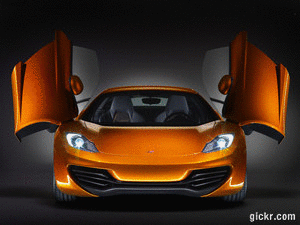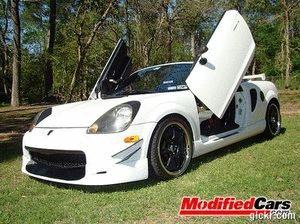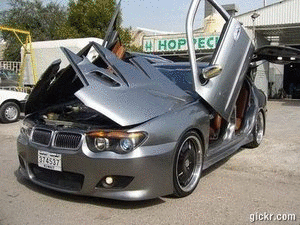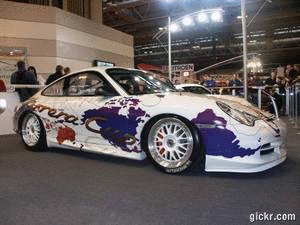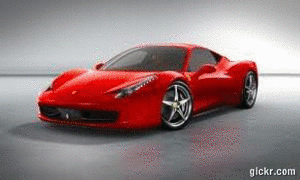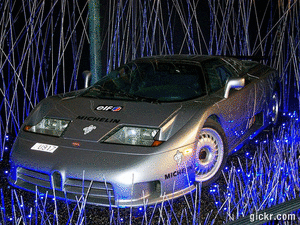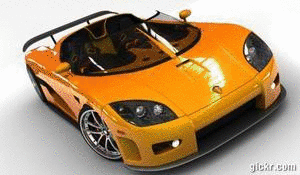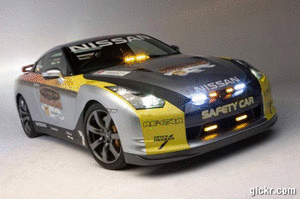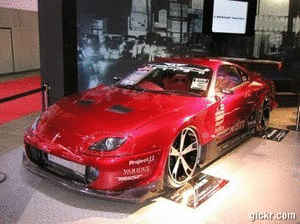Hyundai QarmaQ Concept


The QarmaQ is Hyundai's Advanced Technology Demonstration Vehicle (ATDV) that showcases over 30 different environmentally progressive technologies led by the innovative “Elastic Front™”, an innovative solution that can help reduce the risk of severe injuries in Crossover Utility Vehicles (CUV) pedestrian collisions.
Designed at Hyundai Motor Europe's Design and Technical Center in Russelsheim and engineered in close cooperation with GE Plastics, QarmaQ develops and validates over 30 key technologies, which will be selectively incorporated into Hyundai’s new models to be rolled out from 2008-2014.
The QarmaQ is lighter, stronger and more economical than any current production CUV in its class. It also offers significant recycling advantages both in construction and eventual disassembly. In short, it is a viable and realistic glimpse of the future potential of personal automotive transport.
 Pedestrian Safety
Pedestrian Safety
The issue of pedestrian safety is a growing one. In the EU, one-fifth of all traffic fatalities – 7,000 people per year – are pedestrians hit by a vehicle. In densely populated Korea, the rate is as high as 39 percent. QarmaQ's Elastic Front™ safety system, which encompasses the whole front end of the vehicle, is arguably the world's first global pedestrian protection solution on a CUV. Three energy-absorbing structures are fully integrated underneath the futuristic styling of QarmaQ and this system takes advantage of several advanced materials that offer inherent energy absorbing properties. QarmaQ's body panels have been designed to work in concert with energy-absorbing systems on the underside of these panels to manage and dissipate the force of a pedestrian/CUV collision. The Elastic Front™ has been engineered to meet EEVC WG17 Phase2, Euro NCAP, and JNCA pedestrian impact requirements and is currently undergoing testing for final validation.
 A totally relevant concept
A totally relevant concept
The Hyundai QarmaQ concept car is the result of the fusion of exceptional expertise and engineering foresight from Hyundai and GE Plastics. More than a design concept, QarmaQ illustrates that environmentally responsible solutions can be elegantly incorporated to enhance safety, design and performance.
Firmly positioned as a crossover Coupe/CUV, the QarmaQ derives its name from traditional Inuit dwellings, constructed from earth, whalebone and animal skins. Like them, QarmaQ challenges conventional ideas on construction methods and materials. Also in common with the original structures, it boasts unusual strength, resilience and protection.
By combining leading edge design, advanced engineering techniques and the benefits of GE materials technology, the QarmaQ demonstrates the ability to meet necessary, but problematic areas of legislation dealing with pedestrian safety and eco-responsibility.
Departing from conventional car design that combines a lower body and a glass cabin on top, QarmaQ blazes a new trail with panoramic wrap-around glazing area using GE’s Lexan™ polycarbonate resin. This part sits between the two pronounced “muscles” above the front and rear wheels. The C-shaped side window enables innovative helicopter-like downward visibility and is a key design feature demonstrating the new glazing technology.
Exterior: Fluidity of line
Connected by unique glazed surfaces, the exterior design relates strongly to, and interacts effortlessly with the interior. The unique division between the solid bodywork and transparent glazed areas creates a new perspective, whether viewed from inside or from the pedestrian standpoint.
The exterior contours and fluidity of line have been refined to give an immediate impression of movement frozen in motion. This aesthetic is mirrored in the interior, so that the fusion and merging of the perceptual boundaries between inside and out delivers a feeling of integration and synchronization to the overall appearance.
The QarmaQ’s exterior design communicates a commanding presence and a feeling of protection to the occupants, said Robert Butterfield, global market director, GE Plastics. The twin domes on the sunroof, facilitated by the new glazing technology, increases the inner space for the rear passengers and creates a unique design feature. The wrap-around windscreen, in combination with the elongated bonnet delivers dramatic, almost classic, proportions and gives the car a unique sporty feeling. Finally, the contrast of the strong dark coloured areas to the lighter tonal areas emphasizes QarmaQ’s off-road DNA.
 Iterior
Iterior
In response to shrinking family sizes and emergent customer preferences, QarmaQ is specifically designed to carry four people in above average comfort. The extensive use of new materials and techniques has resulted in a more fluid, more unified interior, by allowing seamless integration of otherwise intrusive elements.
As the sporting exterior proportions suggest, the QarmaQ is primarily a driver’s car. Within its unique interior architecture the cockpit is isolated in an active, yet protective pod structure. This helps promote a sensorial and highly self-indulgent driving experience.
The colour harmony of the interior has been designed to enhance the feeling of serenity and spaciousness, which in turn relates directly to the high level of comfort enjoyed by the passengers. The mixed effects, textures and colours add sophistication to the dynamic forms and strong presence of the car. Functional elements made from aluminium emphasise the more technical aspects, contrasting with and highlighting the softness of the interior materials.
The wrap-around GE Lexan™ windscreen and extensive use of GE polycarbonate glazing materials provides a weight saving of up to 50 percent in relation to glass, while simultaneously allowing more adventurous shapes than flat glass. The glazing features a unique technology from Exatec™ which deposits a thin protective layer of glass on the Lexan™ to add protection from scratching and the effects of weathering.
At the other end, the tailgate breaks new ground by bonding different materials, including the glazing and rear light assemblies, to create a one-piece component structure. This increases the integral strength, while at the same time simplifying vehicle assembly and reducing weight.
Another major safety advance is the use of sensors to detect vehicle presence in the blind spots of the rear view mirrors when pulling out or overtaking, and audio-visually alert the driver.
Euro5 diesel engine
QarmaQ's 2-liter diesel engine is fully compliant with EURO5 emission regulations. It features the very latest technologies such as high pressure fuel injection and fine fuel spray atomization for higher torque and better power output. Regulated emissions such as CO, THC, NOx and PM, were reduced drastically while a Catalyzed Particulate Filter system, CPF, is capable of cleaning about 90 percent of the particulate matter from the diesel emissions. Furthermore, by switching the position of CPF from the under-floor area to a location more closely coupled to the exhaust manifold, it was possible to minimize the catalytic light-off time and to enhance the naturally regenerative characteristics of the CPF.
A greener future
Thanks to extensive use of advanced materials, QarmaQ is 60 kg lighter than a comparable vehicle made with traditional materials.
HPPC composites for horizontal body panels significantly reduce part weight - up to 50 percent per part - while maintaining strength equal to that of steel. This lighter-weight cladding contributes to better fuel efficiency and improved power-to-weight ratio for drivers and its energy absorbing qualities are harnessed to create the Elastic Front™ safety system.
QarmaQ's body panels use an environmental responsible plastic, Xenoy iQ™ and Valox iQ developed as part of GEs ecomagination™ initiative to address three critical environmental concerns: conserving energy, lowering greenhouse gas emissions, and up-cycling or re-using materials such as PET plastic bottles. QarmaQ re -uses approximately 900 PET bottles that would otherwise become landfill.
Another environmentally progressive aspect of the QarmaQ’s design is the use of GE paint replacement technologies, including Visualfx™ resins with Lexan™ films, to replace painting operations that can release toxic and greenhouse gases.
To eliminate dependency on PVC in the wiring, GE’s Noryl™ resin technology was used for wire and cable coating. Replacing PVC, these ultra-thin coatings can reduce cable weight by up to 25 percent.
Designed at Hyundai Motor Europe's Design and Technical Center in Russelsheim and engineered in close cooperation with GE Plastics, QarmaQ develops and validates over 30 key technologies, which will be selectively incorporated into Hyundai’s new models to be rolled out from 2008-2014.
The QarmaQ is lighter, stronger and more economical than any current production CUV in its class. It also offers significant recycling advantages both in construction and eventual disassembly. In short, it is a viable and realistic glimpse of the future potential of personal automotive transport.
 Pedestrian Safety
Pedestrian SafetyThe issue of pedestrian safety is a growing one. In the EU, one-fifth of all traffic fatalities – 7,000 people per year – are pedestrians hit by a vehicle. In densely populated Korea, the rate is as high as 39 percent. QarmaQ's Elastic Front™ safety system, which encompasses the whole front end of the vehicle, is arguably the world's first global pedestrian protection solution on a CUV. Three energy-absorbing structures are fully integrated underneath the futuristic styling of QarmaQ and this system takes advantage of several advanced materials that offer inherent energy absorbing properties. QarmaQ's body panels have been designed to work in concert with energy-absorbing systems on the underside of these panels to manage and dissipate the force of a pedestrian/CUV collision. The Elastic Front™ has been engineered to meet EEVC WG17 Phase2, Euro NCAP, and JNCA pedestrian impact requirements and is currently undergoing testing for final validation.
 A totally relevant concept
A totally relevant conceptThe Hyundai QarmaQ concept car is the result of the fusion of exceptional expertise and engineering foresight from Hyundai and GE Plastics. More than a design concept, QarmaQ illustrates that environmentally responsible solutions can be elegantly incorporated to enhance safety, design and performance.
Firmly positioned as a crossover Coupe/CUV, the QarmaQ derives its name from traditional Inuit dwellings, constructed from earth, whalebone and animal skins. Like them, QarmaQ challenges conventional ideas on construction methods and materials. Also in common with the original structures, it boasts unusual strength, resilience and protection.
By combining leading edge design, advanced engineering techniques and the benefits of GE materials technology, the QarmaQ demonstrates the ability to meet necessary, but problematic areas of legislation dealing with pedestrian safety and eco-responsibility.
Departing from conventional car design that combines a lower body and a glass cabin on top, QarmaQ blazes a new trail with panoramic wrap-around glazing area using GE’s Lexan™ polycarbonate resin. This part sits between the two pronounced “muscles” above the front and rear wheels. The C-shaped side window enables innovative helicopter-like downward visibility and is a key design feature demonstrating the new glazing technology.
Exterior: Fluidity of line
Connected by unique glazed surfaces, the exterior design relates strongly to, and interacts effortlessly with the interior. The unique division between the solid bodywork and transparent glazed areas creates a new perspective, whether viewed from inside or from the pedestrian standpoint.
The exterior contours and fluidity of line have been refined to give an immediate impression of movement frozen in motion. This aesthetic is mirrored in the interior, so that the fusion and merging of the perceptual boundaries between inside and out delivers a feeling of integration and synchronization to the overall appearance.
The QarmaQ’s exterior design communicates a commanding presence and a feeling of protection to the occupants, said Robert Butterfield, global market director, GE Plastics. The twin domes on the sunroof, facilitated by the new glazing technology, increases the inner space for the rear passengers and creates a unique design feature. The wrap-around windscreen, in combination with the elongated bonnet delivers dramatic, almost classic, proportions and gives the car a unique sporty feeling. Finally, the contrast of the strong dark coloured areas to the lighter tonal areas emphasizes QarmaQ’s off-road DNA.
 Iterior
IteriorIn response to shrinking family sizes and emergent customer preferences, QarmaQ is specifically designed to carry four people in above average comfort. The extensive use of new materials and techniques has resulted in a more fluid, more unified interior, by allowing seamless integration of otherwise intrusive elements.
As the sporting exterior proportions suggest, the QarmaQ is primarily a driver’s car. Within its unique interior architecture the cockpit is isolated in an active, yet protective pod structure. This helps promote a sensorial and highly self-indulgent driving experience.
The colour harmony of the interior has been designed to enhance the feeling of serenity and spaciousness, which in turn relates directly to the high level of comfort enjoyed by the passengers. The mixed effects, textures and colours add sophistication to the dynamic forms and strong presence of the car. Functional elements made from aluminium emphasise the more technical aspects, contrasting with and highlighting the softness of the interior materials.
The wrap-around GE Lexan™ windscreen and extensive use of GE polycarbonate glazing materials provides a weight saving of up to 50 percent in relation to glass, while simultaneously allowing more adventurous shapes than flat glass. The glazing features a unique technology from Exatec™ which deposits a thin protective layer of glass on the Lexan™ to add protection from scratching and the effects of weathering.
At the other end, the tailgate breaks new ground by bonding different materials, including the glazing and rear light assemblies, to create a one-piece component structure. This increases the integral strength, while at the same time simplifying vehicle assembly and reducing weight.
Another major safety advance is the use of sensors to detect vehicle presence in the blind spots of the rear view mirrors when pulling out or overtaking, and audio-visually alert the driver.
Euro5 diesel engine
QarmaQ's 2-liter diesel engine is fully compliant with EURO5 emission regulations. It features the very latest technologies such as high pressure fuel injection and fine fuel spray atomization for higher torque and better power output. Regulated emissions such as CO, THC, NOx and PM, were reduced drastically while a Catalyzed Particulate Filter system, CPF, is capable of cleaning about 90 percent of the particulate matter from the diesel emissions. Furthermore, by switching the position of CPF from the under-floor area to a location more closely coupled to the exhaust manifold, it was possible to minimize the catalytic light-off time and to enhance the naturally regenerative characteristics of the CPF.
A greener future
Thanks to extensive use of advanced materials, QarmaQ is 60 kg lighter than a comparable vehicle made with traditional materials.
HPPC composites for horizontal body panels significantly reduce part weight - up to 50 percent per part - while maintaining strength equal to that of steel. This lighter-weight cladding contributes to better fuel efficiency and improved power-to-weight ratio for drivers and its energy absorbing qualities are harnessed to create the Elastic Front™ safety system.
QarmaQ's body panels use an environmental responsible plastic, Xenoy iQ™ and Valox iQ developed as part of GEs ecomagination™ initiative to address three critical environmental concerns: conserving energy, lowering greenhouse gas emissions, and up-cycling or re-using materials such as PET plastic bottles. QarmaQ re -uses approximately 900 PET bottles that would otherwise become landfill.
Another environmentally progressive aspect of the QarmaQ’s design is the use of GE paint replacement technologies, including Visualfx™ resins with Lexan™ films, to replace painting operations that can release toxic and greenhouse gases.
To eliminate dependency on PVC in the wiring, GE’s Noryl™ resin technology was used for wire and cable coating. Replacing PVC, these ultra-thin coatings can reduce cable weight by up to 25 percent.
